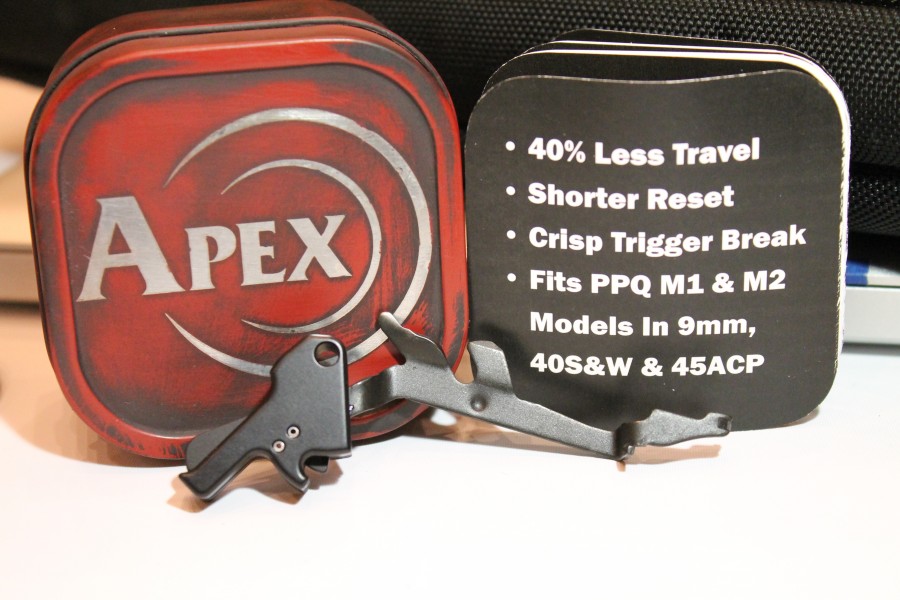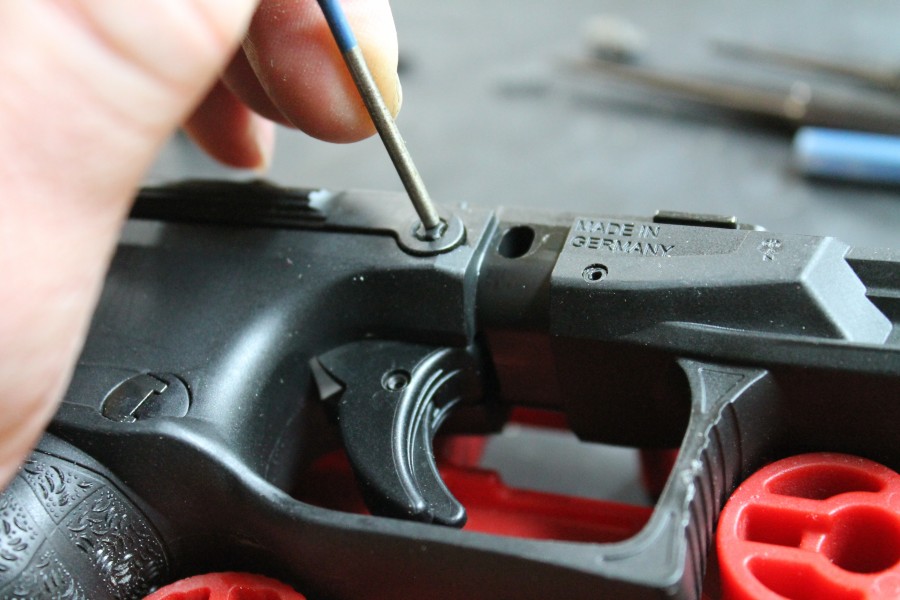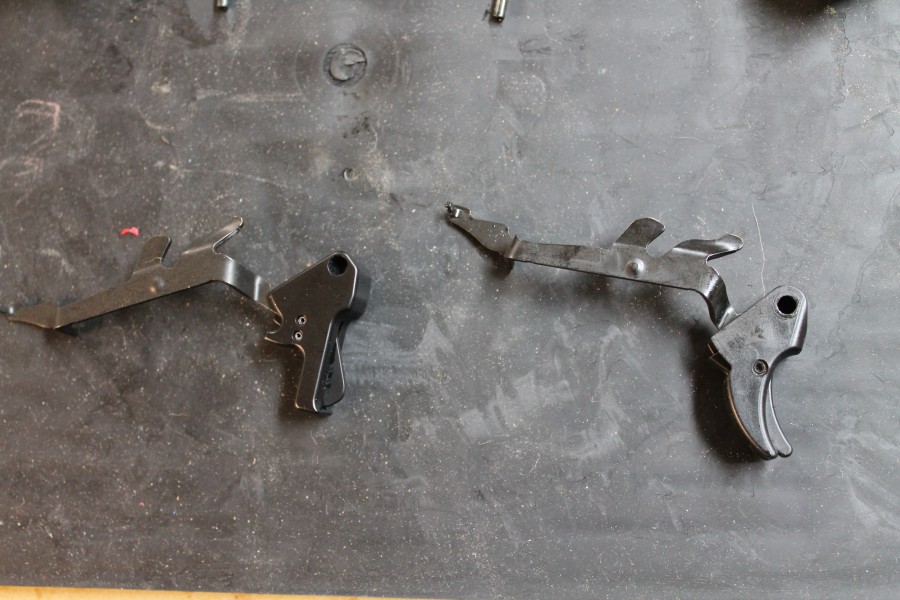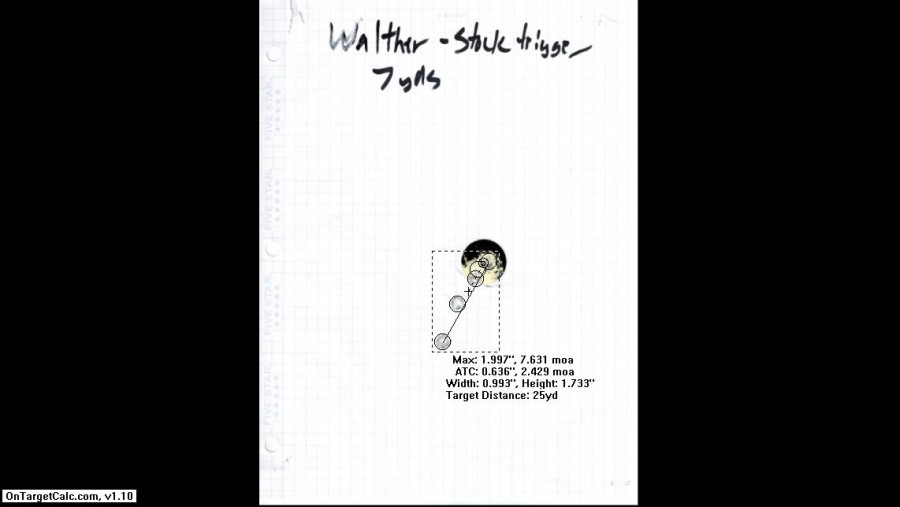
At the end of 2015, the trigger-happy folks at Apex Tactical sent me a T- shirt. It displayed a long list of handguns with checkmarks next to each one. They’ve been “Apex’d.” That shirt is now woefully out of date, a testament to the rapidity with which the California company releases new products in their effort to bring 1911 trigger ergonomics to the striker-fired world. It all started with the introduction of the . . .
“Flatty” forward set trigger kit for the Smith & Wesson M&P, the pistol they’re most known for fixing. The R&D they put into those kits translates well to other striker-fired handguns. Looking through their list of available triggers (the shirt’s in my closet), it’s clear that Apex wants to be more than “THE M&P shop.” At the 2016 SHOT show, the guys from Apex handed me a box containing a trigger assembly for the Walther PPQ.

The comments section of our article announcing the PPQ replacement trigger covered what is sure to be one of the first criticisms of any attempt to improve the PPQ trigger. Essentially, why mess with perfection?
Having squeezed off a few rounds through the PPQ at last year’s Texas Firearms Festival, I walked away surprised at the stock trigger’s essential excellence. It was as crisp and clean as a freshly laundered shirt. The only criticism I could lob in Walther’s direction: the take-up’s a bit too long. Apex’s flat-faced kit claims to handle leverage better and reduce take-up dramatically. But first, you have to install it.

Installation
*Update/Disclaimer* – I received a note from a member of the Walther Customer Service team with a request to convey that this installation, while it looks simple, has the potential to end catastrophically.
I work in Walther’s consumer service, i.e. Warranty dept. One of the things we’ve discussed here lately is user install of this trigger. As was alluded, this isn’t easy on this gun. If done incorrectly, specifically when re-installing the right side slide stop lever, what looks like a job well done will result in a cracked frame two-three shots later.
Where I’m familiar with which pins and gizmos go where in M&Ps and GLOCKs, the PPQ was virgin territory. The Apex trigger installation took something in the order of an hour. Some of that time was spent dealing with the normal challenges of working on a factory fresh gun (on loan from a generous coworker); the pins and such were tighter than metaphor deleted. I also wasted precious moments chasing springs and holding my tongue just right.
Further complicating things: Apex hadn’t released comprehensive documentation on performing the swap. They’ve since remedied that.
Commentators reading my review of the Apex’s GLOCK trigger indicated that my testing methodology was a rigorous as a Coalition to Prevent Gun Violence gun control study. (I used two different guns). So I shot the PPQ before and after swapping the Apex trigger with the factory unit. After installing the Apex trigger in the shop, I got my swap time down to about 10 minutes. (If you follow the instructions and take your time, this process is well within the capabilities of the hobbyist gunsmith.)

Objective Bench Data
Try as we might to get him here, Jeremy S. still doesn’t live in Austin. I didn’t have access to his fancy Dvorak TriggerScan machine. I was forced to rely on a trigger pull gauge and set of dial calipers to measure the changes provided by the Apex trigger. The problem with measuring travel distance using a set of dial calipers: gathering repeatable data is difficult.
Even so, it was readily apparent that the Apex kit made a difference. My own measurements pegged the reduction in travel at something like 60 percent, a highly subjective measure based on caliper placement. I never managed to measure anything less than 40 percent.

The guys at Apex were kind enough to send over the TriggerScan data they’d collected measuring the difference between their trigger kit and the stock unit. I plotted the data and created the graph you see above. It isn’t the fanciest graph on the internet, and yes, this is data from the manufacturer, but from both my coarse measurements and the data I was supplied, it appears that Apex has come through on one of their claims. The Apex Walther PPQ trigger reduces trigger travel significantly.
I tested the stock PPQ trigger over the course of ten pulls, achieving an average pull weight of 5.25 lbs., with the lowest measurement at 4.875 lbs. and the highest being 5.625. The Apex unit reduced average pull weight ever so slightly, to a touch under 5.2 lbs — which might as well be a rounding error. (The lowest pull weight I got was five pounds while the highest was 5.375.) For all intents and purposes, the pull weight is the same. Interestingly, the pull with the Apex trigger was quite a bit more consistent.
As you can see in the videos above, takeup distance has been greatly reduced. Reset certainly seems shorter. Looking at both videos back to back, it appears that Apex has achieved another of its stated goal. Total travel is reduced while still maintaining a fairly safe 5+ pound trigger pull.
Subjective Static Range Impressions
Like the GLOCK flat-faced trigger, I was impressed with the improvement in feel that the Apex unit brings to the PPQ. The PPQ trigger was no slouch, but the Apex is arguably crisper and the shorter takeup and reset make for a very pleasant experience.
One of the nicest things – and something they don’t advertise – is that this kit kills off the overtravel that exists with the stock unit. You can see a glimpse of it in the videos above, and the graph from Apex’s data does a good job of illustrating it as well. There’s simply no wasted movement with the Apex unit. It feels as good as I think a striker fired gun can feel while still maintaining a safe pull weight.
The flat-faced shoe is a welcome addition though I didn’t have any particular gripes with the feel of the stock shoe. Walther did a good job of recessing the safety so I never got any of the GLOCK finger that I spent so much time complaining about in my other review. The flat-faced trigger takes a bit of time to get used to, but if you’ve ever shot a 1911, it feels a bit like that. Going back to the curved shoe feels a bit weird after spending time with the flat style.

Objective Static Range Data
My first order of business upon arriving at the range with the Apex equipped PPQ was to shoot a few five shot groups. The best I could squeeze out was a 1.7 inch group at seven yards. Hardly my best work, but an established baseline nonetheless.

I ran my other testing and then swapped back to the stock trigger. Performing the same schedule of dry firing followed by static five round grouping, I got the group above, a hair under two inches in maximum spread.
I’m certain I could spill quite a few electrons on the shape of these groups and a few more on my own performance, but I’m resigning myself to saying that the Apex trigger helped me shoot ever so slightly better. It’s such a small improvement that it might as well be background noise. Consider it a tie.
Objective Range Data
As some of you may remember, I set out to find an objective means of testing pistols, sights, holsters, etc. and settled upon a test that my instructor, Karl Rehn, put together. There are seven drills in the entirety. For this particular test, I chose Drill #1 and Drill #2 to compare the stock trigger against the Apex.

Scoring: IPSC “minor” scoring (A=5, B/C = 3, D=1).
- Drill 1:
- Round Count: 4 rounds
- Description: Draw, fire 4 on 5 yard target, two handed
- Purpose: Test draw and “hosing” split times
- Goal Time: 2.00 sec (1.25 draw, 0.25 splits x 3)
- Drill 2:
- Round Count: 4 rounds
- Description: Draw, fire 4 on 10 yard target, two handed
- Purpose: Test draw and “medium” split times
- Goal Time: 2.50 sec (1.5 draw, 0.33 split x 3)
I did eight repetitions of Drill #1 with each trigger and then eight and six repetitions of Drill #2. This reduction in repetition count was driven by the fact that I was running short on time and I wanted to collect all my data in one go. I used a Competition Electronics Pocket Pro II and started from a two handed position indexed on my chest to simulate some portion of the presentation phase of the draw.
For each string of fire, I recorded the time to the first shot, the time between shots, and the location of each hit corresponding to the IPSC targeting zones. When I got back home from the range, I plugged all this data into Excel and used Comstock scoring to find my hit factor for each string.

Taking all eight rounds into an average, the scores were within a few tenths of each other between the two triggers. I was slightly slower — and I mean slightly — with the Apex trigger. But I scored a bit better.
Removing the best and worst runs from each group, the average score for the Apex trigger got a bit better while the stock trigger score remained about the same. My second run with the Apex was absolutely awful, and removing it seemed to have boosted the score a bit.
As you can see, the times to first shot and subsequent splits were all within a hundredth of a second of each other on average. Once I kicked out the low and high scores from both runs, it became apparent that the Apex trigger was the winner. As always, I’d love to have more data/ammo/time, but from this limited dataset, I can say that I shot the Apex equipped gun more accurately.

Stepping back to the ten yard line, things went a little off kilter. The presentation times hovered right around a second, and my splits were right around a third of a second. The difference between the splits with either trigger were fairly negligible. I was just a touch faster overall with the Apex on average, but I scored a touch worse with it.
The stock trigger outscored the Apex by a couple tenths, a trend that remained when I kicked out the high and low scores from each run. Where the Apex trigger was the clear winner after normalization at five yards, both guns remained very close at the ten yard line.
Conclusions
On my drive home from the range with the Apex’d GLOCK, I got it into my head that I must have shot miles better with the aftermarket trigger. I had a similar feeling with the PPQ trigger. But just like the GLOCK test, once I started crunching numbers, it was clear that the difference in performance was fairly negligible. The improvement in shooting performance is there if you look hard enough, but it is very minor, and in at least one case, my performance suffered from an objective standpoint by using the Apex trigger.
That said, I think this is still an improvement over the stock PPQ trigger. It feels quite a bit better in both shape and travel. If I owned a PPQ, this wouldn’t necessarily be the first change I’d make, but it would be on the list for the next time I found myself with a spare $130 burning a hole in my pocket.

Specifications: Apex Tactical Walther PPQ Forward Set Trigger
- Parts Included: Replacement Trigger with Trigger Bar
- Install Complexity: Slightly more involved than field stripping
- Intall Time: <30 minutes
- Cost: $129.95
Ratings (out of five stars):
Fit, Finish, Build Quality * * * * *
Workmanship is top notch. All of the contact surfaces are properly radiused and polished. No sharp edges or gritty bits and the bearing surfaces have been properly lubricated and polished.
Overall Feel * * * * *
If you’ve been exclusively using curved triggers, flat-faced trigger takes some acclimatization. Once you spend a few minutes with it, it starts to feel “right.” Engagement distance has been significantly reduced and the overall feel has been tightened up a bit. The stock PPQ trigger feels good, but the Apex trigger feels better. It’s subtle, but the difference is there.
Overall Rating * * * *
The changes Apex made to the shape of the trigger and the shortened travel are real improvements to what some call the best factory striker-fired trigger available.. The Apex trigger helped me shoot ever so slightly better at the five yard line, and every so slightly worse at the ten yard line. Altogether, a wash, much like the GLOCK replacement I tested. If you feel you’ve fully taxed the capabilities of the stock PPQ trigger, the Apex unit is worth the money.




Incorrect installation of the slide release will destroy this gun.
R&R the S&W MPn trigger, certainly… It sucks horribly.
But the PPQ? …as you discussed
IMO why look for a problem where there is none? Skip the trigger upgrade and use the money toward changing the sights.
Agree… for the most particular and ya got the green-go for it.
APEX is excellent. R&R the S&W Shield – no question/needs it also!
APEX makes great stuff. Outstanding and well detailed review.
“Try as we might to get him here, Jeremy S. still doesn’t live in Austin. I didn’t have access to his fancy Dvorak TriggerScan machine”
Look at how sensible it would be to simply mail the gun to him for testing, and have him mail it back with recorded data. But that is hugely illegal, *twice*, because … (crickets) …
EDIT; OOoops. I forgot “before and after”, make “hugely illegal” FOUR times, instead.
More than that, its the overnight shipping of handguns that gets us. I spent $80 the last time I sent a pistol to Apex. Hell, its probably cheaper for him to ship the machine to me with the necessary insurance.
Yeah, definitely easier than sending a handgun both directions. But all-in it’s a pretty big box and insurance would have to be for like $4,000.
We’re thinking that move to Austin may actually happen near the end of 2016, though 🙂
BTW — mad data regardless. One hell of a trigger review. It’s hard to make these things objective and this is a pretty damn successful effort. The course of fire is awesome, and I’ll look forward to joining in on that in TX one day. It’ll be cool to have more of the exact same features and test procedures shared across more TTAG reviews.
…well, why couldn’t you fly him back and forth on RF’s private corp. jet? 😉
Nick doesn’t have that endorsement yet.
Can’t you just spend more and get a better trigger to begin with? THIS seems redundant.
Not if you specifically want a Glock, M&P, PPQ, etc. If you want a superlative trigger with whatever gun happens to be wrapped around it then sure, you could purchase something that way instead.
Ummm…my comment was slightly sarcastic Jeremy. The PPQ is not cheap. Like the Tavor with a 12pound trigger. Similar price to a new GLOCK. So you spend 100-150bucks more to improve a trigger that most people don’t think needs improvement? Not my $…
Oh 🙂
It’s kinda hard to improve on a pure SAO trigger. The PPQ isn’t like a Glock or M&P where the striker is only partially cocked. Honestly, a person can use some sandpaper to save $130 or actually just shoot the damn thing. I guess if takeup really annoys you…
I bought mine for the trigger.
Seems like a subjective improvement (feels better), as opposed to a qualified improvement (test results).
Money better spent on new sights…..
Is the Apex trigger made of metal? The only thing that I don’t like about my PPQ is that the trigger is made of plastic.
It is made of metal
That’s enough for me to buy one. I’m fine with the take-up, reset, and overtravel of the stock trigger, but if the Apex is made of metal, and at least as good in every other respect I would definitely prefer to have it instead.
My PPQ was worth every penny and I can’t see changing the trigger. First I think it uglies the gun a bit and then there is a warranty issue when you modify it. I’m looking to get the .45 version as well
I’ve got the PPQ M2 45. My range had Walther in for demos. The Walther guy asked me what I carry – a Glock 30S. We went into the range and five rounds later I sold the Glock and bought a PPQ. Better in every way.
So far I’ve added tritium sights (stock sights really suck) and a laser. This is my EDC as well as my primary home defense gun. I shoot it at the range without the laser but I like the laser at home because if the door comes down I don’t want to think about aiming. Bought my wife the 9mm CCP, it’s a great gun as well. It’s gas operated so a tad less recoil and easier to rack. I put a laser on hers as well, same reason.
I’ve got the Armalaser GTO on the PPQ. I tried a couple of others but the couldn’t take the recoil, this one is great and it’s $100 on Amazon.
I may add this trigger, I don’t like the takeup, but I’ll put a couple of thousand more rounds through it before I make a decision. I love this gun. Oh, and a stock StickyHolster works great for IWB carry and Armalaser has some options on their website for OWB Kydex holsters.
I like the trigger, but I don’t know if I would ccw with one.
i love my ppq trigger. but i bought a friend the apex flatty for his sig p320,,,,, and WOW. if the flatty for the ppq is even close…. im all in!
People who have installed the Apex “Flatty” in their M&P’s have reported the “dead trigger syndrome” and had to remove it.
Comments are closed.